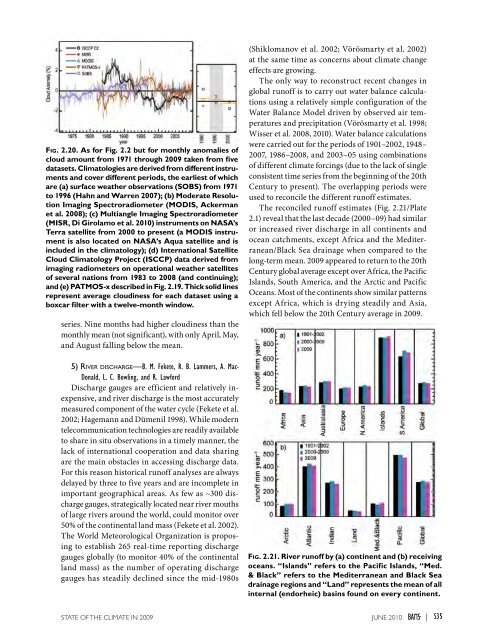You also want an ePaper? Increase the reach of your titles
YUMPU automatically turns print PDFs into web optimized ePapers that Google loves.
Fig. 2.20. As for Fig. 2.2 but for monthly anomalies ofcloud amount from 1971 through <strong>2009</strong> taken from fivedatasets. Climatologies are derived from different instrumentsand cover different periods, the earliest of whichare (a) surface weather observations (SOBS) from 1971to 1996 (Hahn and Warren 2007); (b) Moderate ResolutionImaging Spectroradiometer (MODIS, Ackermanet al. 2008); (c) Multiangle Imaging Spectroradiometer(MISR, Di Girolamo et al. 2010) instruments on NASA’sTerra satellite from 2000 to present (a MODIS instrumentis also located on NASA’s Aqua satellite and isincluded in the climatology); (d) International SatelliteCloud Climatology Project (ISCCP) data derived fromimaging radiometers on operational weather satellitesof several nations from 1983 to 2008 (and continuing);and (e) PATMOS-x described in Fig. 2.19. Thick solid linesrepresent average cloudiness for each dataset using aboxcar filter with a twelve-month window.series. Nine months had higher cloudiness than themonthly mean (not significant), with only April, May,and August falling below the mean.5) River discharge—B. M. Fekete, R. B. Lammers, A. Mac-Donald, L. C. Bowling, and R. LawfordDischarge gauges are efficient and relatively inexpensive,and river discharge is the most accuratelymeasured component of the water cycle (Fekete et al.2002; Hagemann and Dümenil 1998). While moderntelecommunication technologies are readily availableto share in situ observations in a timely manner, thelack of international cooperation and data sharingare the main obstacles in accessing discharge data.For this reason historical runoff analyses are alwaysdelayed by three to five years and are incomplete inimportant geographical areas. As few as ~300 dischargegauges, strategically located near river mouthsof large rivers around the world, could monitor over50% of the continental land mass (Fekete et al. 2002).The World Meteorological Organization is proposingto establish 265 real-time reporting dischargegauges globally (to monitor 40% of the continentalland mass) as the number of operating dischargegauges has steadily declined since the mid-1980s(Shiklomanov et al. 2002; Vörösmarty et al. 2002)at the same time as concerns about climate changeeffects are growing.The only way to reconstruct recent changes inglobal runoff is to carry out water balance calculationsusing a relatively simple configuration of theWater Balance Model driven by observed air temperaturesand precipitation (Vörösmarty et al. 1998;Wisser et al. 2008, 2010). Water balance calculationswere carried out for the periods of 1901–2002, 1948–2007, 1986–2008, and 2003–05 using combinationsof different climate forcings (due to the lack of singleconsistent time series from the beginning of the 20thCentury to present). The overlapping periods wereused to reconcile the different runoff estimates.The reconciled runoff estimates (Fig. 2.21/Plate2.1) reveal that the last decade (2000–09) had similaror increased river discharge in all continents andocean catchments, except Africa and the Mediterranean/BlackSea drainage when compared to thelong-term mean. <strong>2009</strong> appeared to return to the 20thCentury global average except over Africa, the PacificIslands, South America, and the Arctic and PacificOceans. Most of the continents show similar patternsexcept Africa, which is drying steadily and Asia,which fell below the 20th Century average in <strong>2009</strong>.Fig. 2.21. River runoff by (a) continent and (b) receivingoceans. “Islands” refers to the Pacific Islands, “Med.& Black” refers to the Mediterranean and Black Seadrainage regions and “Land” represents the mean of allinternal (endorheic) basins found on every continent.<strong>STATE</strong> <strong>OF</strong> <strong>THE</strong> <strong>CLIMATE</strong> <strong>IN</strong> <strong>2009</strong> juNE 2010 |S35
















